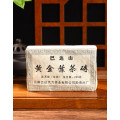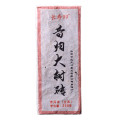A brief introduction of Pu-erh tea
Pu-Erh Tea is one of the ten most famous teas in China. Pu-erh tea is named for its origin place Pu-erh City, Yunnan Province.
It is a large-leafed type tea from Yunnan province and has been famous as a traditional Chinese medicinal tea with a long history. The earliest records of Pu-erh tea could date back to the Tang Dynasty (618 AD-906 AD) when it was the nobleman's favorite tea at that time.
Nowadays the terminology Pu-erh mainly refers to the tea type exclusively produced in Yunnan province. Pu-erh tea is a kind of fermented tea, mainly in the form of loose tea or pressed convenient shapes like brick, cake or ball, etc.
Pu-erh tea is divided into raw and ripe according to the processing process
Pu-erh tea is made from Yunnan sun-dried large-leaf green tea through special processing technology. Generally, Pu-erh tea could be classified as raw type, ripened type and aged type in terms of processing skills and aging procedure.

Raw Pu-erh and Ripe Pu-erh
Raw Pu-erh: pressed maocha that has not undergone wet piling (wòduī渥堆) fermentation process, high quality green pu-erh is highly sought after by collectors.
Ripened Pu-erh: maocha that has undergone an accelerated fermentation process lasting 45 to 60 days on average.

Comparison Of Raw and Ripe Tea Liquid
Aged raw Pu-erh, a type of pu-erh tea that has undergone slow natural secondary oxidation and microbial fermentation for years.
Guess about the origin of the saying that Pu-erh tea is helpful to lose weight
I found that the argument that Pu-erh tea has slimming effects seems to be related to the eating habit of Tibetan residents who like to drink Pu-erh tea to neutralize the greasy after eating too much meat.
Tibet is located at high altitude, where the climate is not suitable for growing vegetables. Moreover, as the residents in Tibetan areas eat meat and dairy products every day, these foods contain high-quality protein and fat. If protein and fat accumulate too much in the body, it will have a negative impact on the digestive system. So people in Tibet have the habit of drinking tea.
Tea culture on the Tibetan Plateau has a history of more than one thousand years. in Tibetan, tea is called "荚Jia" derived from the pronunciation of "tea" in ancient times. The local people think that tea can promote the digestive process, quench their thirst, eliminate uncomfortable greasy feelings and keep healthy, so tea is essential to their life.
But one thing that must be clarified is that even though Pu-erh tea is good for your digestive system and helps you digest fat, it doesn't mean that drinking Pu-erh tea is the key to successful weight loss or that it will help you lose weight. Those who believe Pu-erh tea is effective for losing weight have some evidence to support it, and so do those who don't. Next I will give you an overview of the chemicals in Pu-erh tea. Next, I will give you an overview of the chemical substances contained in Pu'er tea. All this, of course, is based on the research of modern researchers, who have provided us with answers to some questions that traditional tea knowledge cannot answer.
Main chemical substances contained in Pu-erh tea
Chemical substances in Pu-erh tea include protein and amino acids, alkaloids, tea polyphenols, sugars, organic acids, lipids, pigments and so on. I'll cover this in more detail in another post.
Some theoretical basis for reducing weight with Pu-erh tea
Please note that the following content are for reference only, and should not be regarded as absolute fact! If in doubt, be sure to consult a doctor!

Chemicals In tea
Some supporters believe that drinking Pu-erh tea can help lose weight.They believe that tea helps people lose weight through the joint action of chemistry, physics and microbes. Here are some of their opinions.
1. Chemical effects
Tea contains many chemicals which are beneficial to health. Natural substances such as tea polyphenols, catechins and vitamin c in Pu-erh tea can help remove the fat accumulated in the body, promote the excretion of cholesterol, and have the effect of healthy weight loss. So drinking a cup of Pu-erh tea every day can promote the metabolism of the body without any side effects on the body.
2. Physical impacts
Pu-erh tea has the function of stretching the intestinal wall, which can make the intestinal tract push food to move faster, reduce the stay time of food in the intestinal tract, and so prevent the intestinal tract from absorbing too much nutrients.
So proponents believe that drinking a cup of ripe pu-erh tea after a meal can help metabolize excess body fat.
3.The role of microorganisms
The main microorganisms generated during the fermentation of Yunnan Pu-erh tea are aspergillus niger, penicillium spp, yeast spp, rhizopus spp, as well as a few bacteria and no pathogenic bacteria.
These microbial life activities and metabolites are important factors in the formation of the quality of Pu-erh tea. During the natural fermentation process of Pu-erh tea, a variety of beneficial flora appear, such as aspergillus niger and saccharomyces spp. They can help digestion and promote the metabolism of human body, thus being beneficial to weight loss.
Some people who hold opposite views have different opinions.They think that tea polyphenols have antioxidant properties.Drinking Pu-erh tea can prolong the fat decomposition rate.Moreover, Pu-erh tea contains a lot of tannic acid, which can be synthesized with protein to converge tannic acid protein, so as to slow down intestinal peristalsis and prolong retention time of intestinal feces. Not only is it easy to cause constipation, but it will also increases the possibility of toxic substances and carcinogens being absorbed by the human body, which will endanger human health.Therefore, drinking Pu-erh tea to lose weight is not worth the cost. Now let's look at an interesting experiment.
A paper on whether Pu-erh tea can help to lose weight
Pu-erh tea has a long history and is one of the traditional famous teas in China. Pu-erh tea attracts a large number of lovers, especially those with good quality, although their prices are prohibitive. The lipid-lowering and weight-loss effects of pu-erh tea have been confirmed by studies, however, most of the previous studies were observational and the mechanism of lipid-lowering and weight-loss of pu-erh tea has not been clarified.
So can pu-erh tea lower fat or not?
The research team of Professor Jia Wei, Chair Professor of School of Chinese Medicine, Hong Kong Baptist University and Director of the Sixth People's Hospital and Center for Translational Medicine, Shanghai Jiao Tong University, has been conducting research related to Pu-erh tea for almost 10 years. Recently, their research on the lipid-lowering mechanism of Pu-erh tea was published in Nature Communication, a sub-journal of the internationally renowned academic journal Nature, entitled "Theabrownin from Pu-erh tea attenuates hypercholesterolimia via modulation of gut microbiota and bile acid metabolism". This paper describes that theabrownin in Pu-erh tea improves hypercholesterolemia by modulating gut microbiota and bile acid metabolism.
This team worked on two main questions:
1. Verify whether Pu-erh tea has the effect of reducing fat and weight.
2. If Pu-erh tea can reduce fat and lose weight, what is its mechanism?
1. Animal test: it was carried out on mice. After a week of standard diet, the experimental mice were randomly divided into 4 groups, with 8 rats in each group.
1) Normal group (ND): normal diet + sterile water

An Old Tibetan Is Drinking Tea
2) Puerh tea group (ND + PTea): normal diet + Puerh tea
3) High-fat diet group (HFD): high-fat diet + sterile water
4) High-fat diet pu-erh tea group (HFD +PTea): high-fat diet + pu-erh tea
Within 26 weeks, the weight, food intake and water/tea consumption of mice were recorded once a week. Blood, intestinal contents and feces were collected at the end of the experiment.
Results: mice consuming Pu-erh tea had significantly lower body weight than the control group without tea consumption without any change or even increase in diet and the total triglyceride and total cholesterol levels in serum and liver were significantly reduced.
2. Human testing

Making Tibetan Butter Tea
Thirteen healthy male volunteers (24-32 years old) were recruited to consume 3 grams of Pu-erh tea daily for 4 weeks after a standard diet for one week.Blood and stool samples were collected at the end of the experiment.
Results: After drinking Pu-erh tea continuously for 4 weeks, the volunteers had no significant weight loss but the serum triglyceride and total cholesterol levels were significantly reduced.
What are the effective chemical components in pu-erh tea for fat and weight reduction?

EGCG In Tea Helps Digest Fat
The analysis of intestinal bacteria in the intestinal contents, feces and volunteer feces of tea-drinking mice revealed that the abundance of bacteria containing bile salt hydrolase (BSH) in the intestine and feces was significantly reduced, and the functional activity of bile salt hydrolase (BSH) was significantly decreased after tea drinking, which led to a significant increase in the level of conjugated bile acids (conjugated bile acids can activate hepatic bile acid synthase and promote the metabolism of cholesterol synthesis bile acids (BSH activates hepatic bile acid synthase, which facilitates the metabolism of cholesterol to bile acids, thereby reducing cholesterol levels).
To explore the active ingredients of pu-erh tea that lead to the decrease of bacterial BSH function, the researchers analyzed by correlation analysis technique and found that the high content of tea brown pigment in pu-erh tea was highly correlated with BSH bacteria.
In order to verify whether theaflavin is the effective component of pu-erh tea in lowering lipids, a mouse test was conducted with two groups of mice, 8 mice in each group.
(1) Pu-erh tea group (HFD+PTea): high fat diet + Pu-erh tea
(2) Tea-fucoid group (HFD + tea-fucoid): high-fat diet + tea-fucoid flush
Blood was collected after 8 weeks for analysis.

Regular Exercise Makes You Healthier
Results: After 8 weeks, compared with pu-erh tea group, theafulin group had the same or more obvious effect of reducing cholesterol and triglyceride, which proved that theafulin is an effective chemical component of reducing fat and reducing weight in Pu-erh tea.
How does theaflavin exert its lipid-lowering effects?
In order to study how theaflavin works, researchers randomly divided germ-free mice into 2 groups, each with 7 mice. One group transplanted with intestinal flora of mice treated with high-fat diet, and the other group transplanted with intestinal flora of mice treated with high-fat diet and theaflavin.
Results: The body weight and blood lipid indexes of the mice transplanted with theaflavin intestinal bacteria were significantly lower than those of the mice transplanted with high-fat diet intestinal flora, indicating that intestinal bacteria have a crucial role in lowering blood cholesterol and triglycerides.
Through this comparative experiment, we know the fact that the slimming effect of Pu-erh tea may not be so obvious as some people think. But this experiment also proves from another angle that drinking Pu-erh tea every day is indeed good for our health. Because there are many kinds of Pu-erh tea, and everyone's physique is different, how much Pu-erh tea can help people lose weight is still a question worthy of in-depth study.
Hints and Suggestions
Pu-erh tea can regulate intestinal microbes and play a role in improving blood lipids and liver lipid homeostasis. Drinking Pu-erh tea regularly could be a good way to maintain health, but it can not replace medication for treating hypercholesterolemia. In addition, for the friends who want to lose weight, don't think that just drinking Pu-erh tea is good for losing weight! Drinking Pu-erh tea doesn't mean getting thinner! To really slim down, eat less and exercise more!




Leave your comment